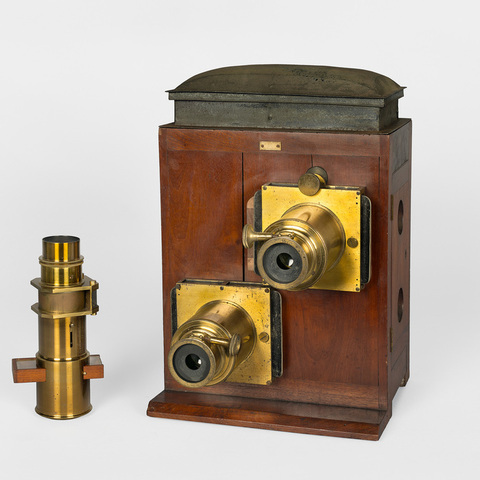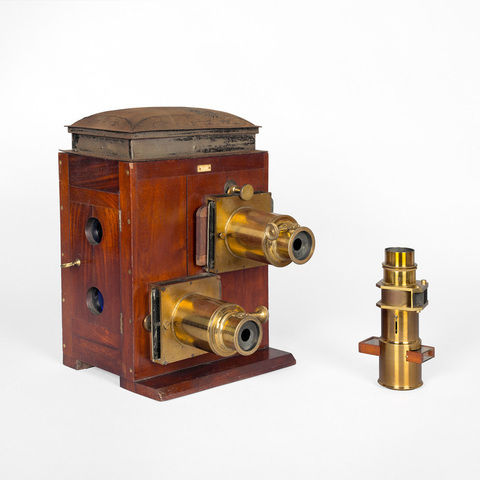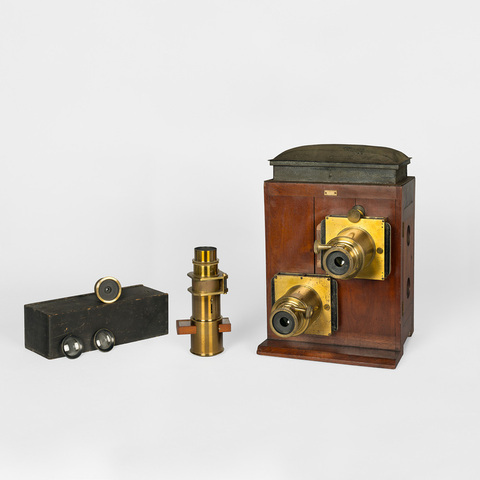Lanterne de projection pour vues microscopiques
Fiche détaillée
Type de l'appareil
lanterne de projection en bois à deux objectifs disposés en diagonale ; objectifs télescopiques à crémaillères ; passe-vues ; cheminée ; deux supports intérieurs pour chalumeaux oxhydriques ; deux portes avec deux ouvertures à verres bleu ; troisième objectif supplémentaire, pour la projection des vues microscopiques, rangé dans une boîte en bois et contenant aussi une cuve en verre et bois
Auteurs
Informations non disponibles
Fabricants
John Benjamin Dancer
Manchester, 13 Cross Street
Utilisateurs
Informations non disponibles
Distributeurs
John Benjamin Dancer
Manchester, 13 Cross Street
Sujet du modèle
Informations non disponibles
Objectif
Informations non disponibles
Taille de l'objet
Ouvert :
Informations non disponibles
Fermé :
Longueur : 42 cm
Largeur : 36 cm
Hauteur : 50 cm
Diamètre :
Informations non disponibles
Taille de la boîte de transport
Longueur : 35 cm
Largeur : 12.5 cm
Hauteur : 11 cm
Remarques
Marque : "J. B. Dancer Optician Manchester". Sur la boîte en bois contenant l'objectif pour vues microscopiques, nom et date au crayon : "H. Brogden 1867".
Un autre exemplaire (incomplet, manquent cheminée et bas) dans la collection David Francis.
"John Benjamin Dancer (London, 1812 - Birmingham, november 1887). English inventor of the microphotograph, magic lantern innovator, and one of Manchester's most important 19th-century scientific instrument makers. In 1835, John took over his father Josiah's instrument-making business. He continued in business in Liverpool until 1841, when he entered into partnership with A. Abraham, a scientific instrument maker of Lord Street, Liverpool. He moved to Manchester to establish a branch of the business (as Abraham & Dancer) at 13 Cross Street. The partnership ceased in 1845. Dancer continued in business under his own name until 1878 when part of it was transferred to his daughters, Elizabeth Eleanor and Anna Maria. Dancer became well known for selling good-quality instruments at a relatively low price. He received several honours which reflected the high quality of his microscopes - including a prize medal at the International Exhibition in London - and was appointed Optician in Macnester to the Prince of Wales. [...] Dancer is credited with introducing photography to Manchester. He took the earliest know photograph of the city in 1842. In February 1852 he produced his first microphotographs - tiny pictures on microscope slides, viewed through a microscope or viewer. They became very popular. [...] At the London Exhibition of 1862, Dancer received an honourable mention for his invention. [...] In 1853 Dancer produced the first binocular stereoscopic camera, with which two pictures could be taken simultaneously at the correct distance apart. After improvements, he patented this design three years later, the first time he had protected any of his inventions in this way. Dancer also made improvements to the magic lantern. While still in Liverpool, in 1837, he had used limelight, previously used in signalling, to increase the intensity of the illumination. This enabled an image 15 feets across to be projected from the back of a large lecture hall. Though others had used limelight for projection by that date, in his autobiography Dancer claimed to have been the first. He continued to make improvements to the magic lantern after his arrival in Manchester : he developped a new dissolving tap, to allow one image to be faded into another, and redesigned the optical systems so that the centres of both images were as near to each other as possible. In the early 1850s he made some of the first photographic lantern sildes using the collodion process, and is know to have provided over 30 photographic slides for an exhibition at the Mechanics Institute in January 1854. The superior quality of his photographs led to about 20 painted slides being discarted before the end of the show. In 1857, dancer introduced the Fairy Fountain, a show with scores of minor jets in a variety of forms and colours. [...] In 1998 the Museum of Science and Industry in Manchester acquired Dancer's microphotograph negatives, complementing the existing collection of over 180 microphotographs" (Jenny Wetton, "John Benjamin Dancer", in David Robinson, Stephen Herbert, Richard Crangle, Encyclopaedia of the Magic Lantern, London, Magic Lantern Society, 2001, p. 83-84).
L'utilisateur de cet appareil, Henry Brogden (1828-1913), né à Manchester, troisième enfant de l'industriel John Brogden (1798-1869) spécialisé dans la construction des gares et chemins de fer, fut membre de la Geological Society et de l'Institution of Mechanical Engineers.
"This lantern is one of the most perfect and high-class lanterns of the present day. Mr. Dancer, of Manchester, is an optician of high standing, and a gentleman to whom the scientific world is indebted for many valuable inventions. He was the first to produce micro-photographs. He was the first to apply the lime light to the lantern, and also the first who exhibited photographic transparencies in the lantern. He is also the inventor of the dissolving tap, and was the first to apply achromatic powers to the lantern, and also to use house gas direct from the main, with oxygen, to produce the lime light. From this we may conclude that he has devoted much tiime and attention to the development of the lantern. In his lantern, one body combines in it the two optical systems, which are placed diagonally. By this arrangement the axes are brought as near to each other as possible, still allowing ample room for the manipulation of the slides either horizontally or vertically, the latter being convenient for effects, such as balloon ascents, etc. The disc are brought concentric on the screen, by an adjusting screw brought through and arranged at the back of the lantern. The heat emanating from the lower jet in no way affects the upper one ; no tall chimney is requisite, and a neat flat top is arranged so that no light can escape, while ample provision is made for the exit of the heated air, and perfect ventilation is secured. The powers are of the highest class, fixed upon telescopic brass tubes, so that objectives of long or short focus can be used. The condensers are of the best construction, and are mounted with due regard to expansion, the mounts being provided with apertures through which any moisture may escape, the whole being fitted into the lantern and secured in its place by a bayonet joint. When required, this lantern can be fitted with an excellent and novel clockwork arrangement for giving to the limes a rotating also a vertical movement. The jets are of the best description, fitted with platinum points, and arranged either to burn mixed-gases, as a safety blow-through, or for oxy-calcium. A dissolving tap is fixed at the back, with adjusting screws to regulate the supply of hydrogen in each lantern for maintaining a light when the oxygen is turned off, and the whole of the adjustments so arranged as to be within easy access to the operator, thus making a most complte and self-contained instrument" (W. J. Chadwick, The Magic Lantern Manual, London, Frederick Warne and Co., s.d. [1878], p. 67-68).
"Optician by Appointment to the Prince of Wales. J. B. Dancer, 43, Cross Street, Manchester, Manufacturer of Mathematical & Philosophical Instruments, The new three-power field and opera glasses, meteorological instruments. Standard barometers, aneroids, thermometers, ozone test papers and cages. Dancer's improved magic lanterns, and new dissolving view apparatus, with the economical dissolving taps. Oxy-hydrogen blowpipes, gas bags and pressure boards. Lime cylinders and cakes. Paintings and photo views for the lantern in great variety. Microscope slides with animal, vegetable, and insect preparations. Micro photos supplied to the trade. Spectacles, eye glasses and artificial human eyes. Prize Medal, 1862" (publicité in W. J. Chadwick, The Magic Lantern Manual, London, Frederick Warne and Co., s.d. [1878]).
Bibliographie
W. J. Chadwick, The Magic Lantern Manual, London, Frederick Warne and Co., s.d. [1878], p. 67-68.
Jenny Wetton, "John Benjamin Dancer", in David Robinson, Stephen Herbert, Richard Crangle, Encyclopaedia of the Magic Lantern, London, Magic Lantern Society, 2001, p. 83-84.


